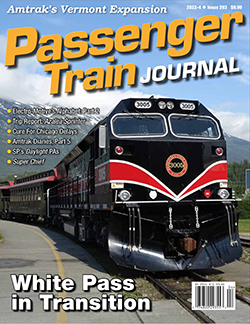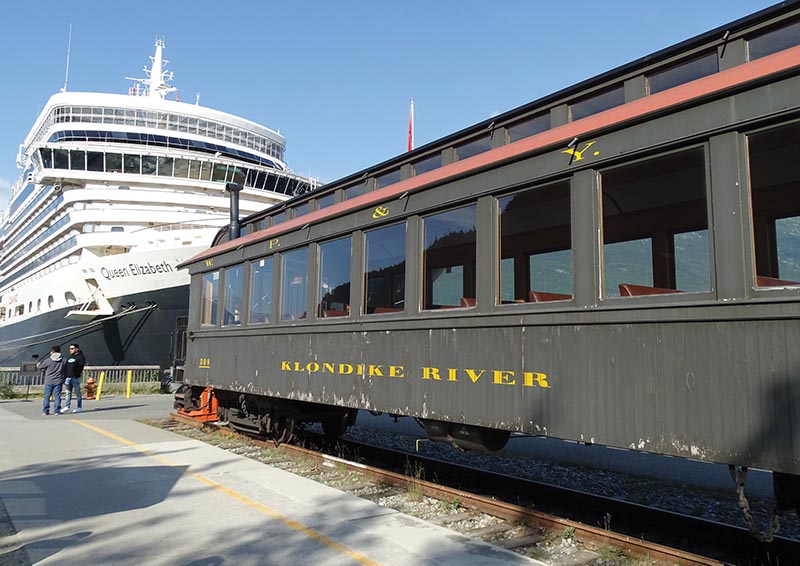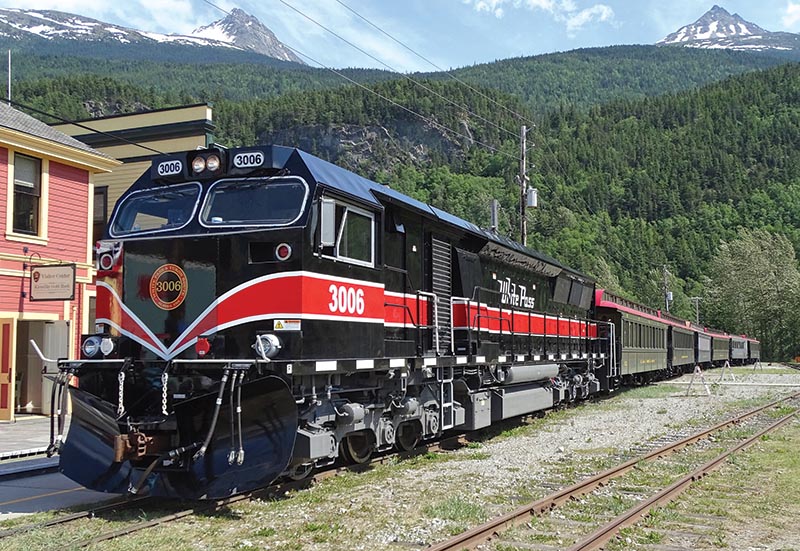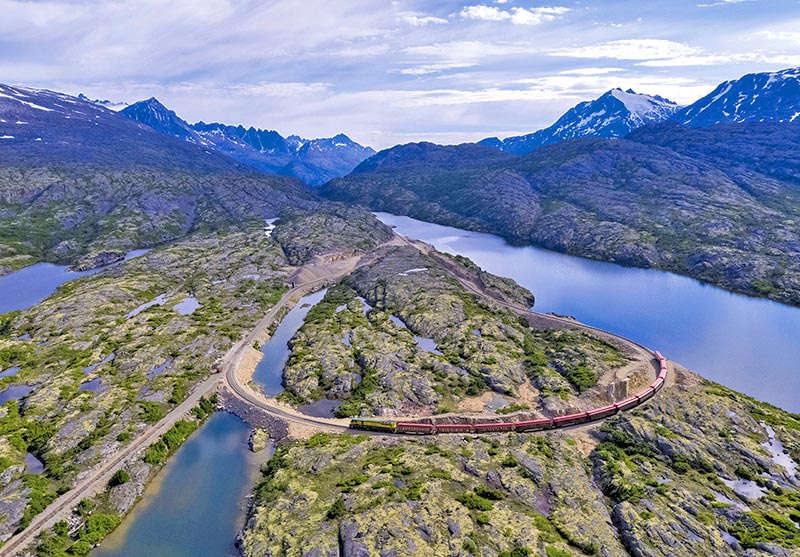 by Kevin J. Holland/photos as noted
by Kevin J. Holland/photos as noted
When the three-foot-gauge White Pass & Yukon Railway — dating to 1898 and built to support the Klondike gold rush — was revived in 1988 after a six-year shutdown triggered by the collapse of its ore traffic, its new management placed their faith in passengers rather than freight for the line’s future prosperity. That gamble was rewarded, as WP&Y’s second act coincided with burgeoning growth in the Alaska cruise industry.
Although small ships catering to locals and adventurous tourists had long sailed the scenic Inside Passage between Seattle or Vancouver and ports in the Alaskan Panhandle, the 1980s ushered in significant increases in both the size of these ships and the number of sailings in the relatively short Alaska season (typically from May to October). From that point on, WP&Y’s fortunes were inextricably linked to the cruise ships that visited Skagway, Alaska’s northernmost Panhandle port of call.

ABOVE: The vintage appearance of WP&Y coach 308, Klondike River, belies the car’s relative youth. It is one of six coaches built in Colorado by Bear Town Mechanical Design in 1998, as the first all-new cars delivered to the revived WP&Y. (The reactivated railway had built 11 cars in its own shops between 1992 and 1994, using existing National Steel Car flat cars, delivered in 1969, as frames.) Cunard’s Queen Elizabeth, moored at Broadway Dock on June 18, 2022, illustrates the proximity of ships and trains in Skagway. —Kevin J. Holland photo
Previously running 110 miles between Skagway and Whitehorse, the capital of Canada’s Yukon Territory, the reactivated WP&Y initially employed only 20.4 miles of the moribund main line, between the docks at Skagway and the Canadian border at the summit of White Pass. The 2,865-foot change in track elevation between those two points had always made for challenging operations, with grades approaching 4 percent, two tunnels, and several cliffhanging bridges along the way. As it happens, the White Pass summit (which marks the U.S.-Canada border, separating Alaska and British Columbia) isn’t quite the highest track elevation on the railway; that’s at Meadows, B.C. (2,924 feet), some four miles farther north.
Traffic growth through the 1990s and the first decade of the 21st century saw WP&Y acquire a steady flow of new (but vintage-looking) coaches to keep up with demand, replacing worn-out cars and increasing overall capacity. For motive power, the revived railway picked up exactly where it left off, reactivating 11 stored Alco-GE shovel-noses and eight MLW DL-535 road-switcher diesels from its pre-shutdown roster. Numbered 90-100, the GE shovel-nose units, with Alco 6-251B prime movers, were built at Erie, Pa., between 1954 and 1966. Ordered to handle new ore traffic, seven DL-535s were built in Montreal in 1969. Two were destroyed in October of that year, before entering service, when WP&Y’s Skagway roundhouse burned. Three more DL-535s arrived from MLW in 1971.
Even with growing tourist traffic, this was more power than the revived road’s management felt was needed at the time, and five of the MLWs were sold to Sociedad Colombiana de Transport Ferroviaro, Colombia’s national railway, in 1992. With WP&Y’s traffic continuing to grow, however, all five were repurchased and returned to Alaska in 1999. In the interval, WP&Y also took delivery of a single DL-535E, a wide-nosed variant of the earlier DL-535, in 1995. A four-unit order for this model had been completed by MLW successor Bombardier in 1982, but the railway’s shutdown left them in storage in Quebec, with WP&Y 114 the only one to eventually make its way to Alaska. Also revived in 1988 was WP&Y’s 1950s green-and-yellow diesel livery, which had been replaced by blue and white, and then by solid blue, in the last years of the line’s pre-shutdown operation by Federal Industries.

ABOVE: The remaining four NRE units arrived in this black paint scheme, retaining the traditional White Pass “speed lettering.” —Kevin J. Holland
Steam even made a comeback on the reborn railway. Built for WP&Y by Baldwin in 1947, Mikado-type 2-8-2 engine 73 was the last steam locomotive acquired by WP&Y. Following its retirement in 1964 and more than a decade of static display at Bennett, B.C., in 1979 the engine was moved to Whitehorse for a restoration that was completed in 1982 — just in time for the railway’s shutdown. Mikado 73 returned to prominence when WP&Y service resumed in 1988. A two-year restoration was completed in 2014, and another in 2019 — the latter, unfortunately, just in time for the pandemic shutdown. A second original White Pass steam locomotive, 2-8-0 Consolidation-type 69, was repatriated by the railway in 2001. Built by Baldwin in 1908, it was restored and returned to operation for its centennial in the 2008 season. After being suspended during the pandemic, the railway announced that steam operations were expected to resume in 2023.
Following the revival of the route between Skagway and White Pass summit in May 1988, management’s goal to reopen at least some of the main line’s Canadian mileage to regularly scheduled service was achieved in increments, first to Fraser (in 1989) and Bennett (1992) in British Columbia, and then as far as Carcross in the Yukon in 2007.
In 2010, preliminary discussions began between the railway, governments, and industry stakeholders regarding the possible reopening of the remaining mileage all the way to Whitehorse, and resumption of freight traffic, including moving ore by rail, to the port at Skagway, but those efforts have not yet come to fruition…


